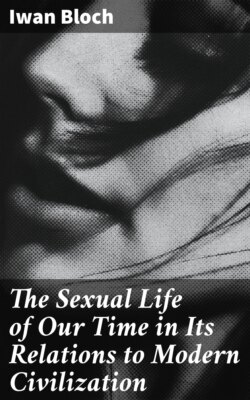Читать книгу The Sexual Life of Our Time in Its Relations to Modern Civilization - Iwan 1872-1922 Bloch - Страница 17
На сайте Литреса книга снята с продажи.
Оглавление[13] Apart from Strindberg and Weininger, who advocate, for the salvation of the future and as ideals of development, the most pronounced and one-sided development of the masculine type, I need refer only to “The Physiological Weakmindedness of Woman” by Möbius, and to such writings as B. Friedländer’s “Renaissance des Eros Uranios” (Berlin, 1904), and to Eduard von Mayer’s “The Vital Laws of Civilization” (Halle, 1904), as characteristic symptoms of such a reaction.
[14] Itching, Tickling, and Sexual Sensibility.—On September 2, 1890, Dr. Bronson, Professor of Dermatology in the New York Polyclinic, read before the American Dermatological Association a paper on “The Sensation of Itching” (printed in the New York Medical Record of October 18, 1890, and republished by the New Sydenham Society in 1893 in a volume entitled “Selected Monographs on Dermatology”). In this paper the author deals at some length with the relations between itching and the voluptuous, or, as he calls it, the “aphrodisiac,” sense. He also denies the specific character of sexual sensations, and states that the aphrodisiac sense “is but a higher development of the primitive sense of contact. It has a special organ or instrument—the penis in the male, the clitoris in the female. Moreover, it is distributed over the entire cutaneous surface” (New Sydenham Society, op. cit., p. 314). In this connexion, and more particularly apropos of Dr. Bloch’s statement on the previous page that “the function of the clitoris is expressed by its name” (German, Kitzler), it is interesting to note that in German the word Kitzel variously denotes—(1) tickling, (2) itching, (3) sexual desire, (4) sexual gratification. The more commonly employed German term for itching, Jucken, does not possess any secondary sexual signification; but, as Dr. Bronson points out (op. cit., p. 312), “both the English words itch and itching, and the Latin prurio and pruritus, in their secondary significations, convey the idea of a longing, teasing desire, while pruritus was commonly used by the Latins as a synonym for lasciviousness.” The same idea is, of course, conveyed by the English derivations, pruriency and prurient. Thus, we see that the familiar terminology of these three tongues (and doubtless of many others) refuses to countenance Hirschfeld’s view regarding the specific character of sexual sensibility.—Translator.
[15] In his profound essay, containing a number of new points of view, “Concerning the Emotions” (Monatsschrift für Psychiatrie und Neurologie, 1906, vol. xix., Heft 3 and 4), Dr. Edmund Forster has ably discussed these primitive relations between voluptuous sensation and pain. According to him, the sexual tension, which commences at the time of puberty, is an increased stimulus of the sensory nerves of the genital organs. The positive sensation-tone of libido accompanying ejaculation represents the relief of the painful, disturbing sensation of sexual tension, and for this reason it has a pleasurable tone.
[16] Carpenter perceives in this “sense of contact” the essence of all sexual love.
[17] For this reason many ingenious prostitutes wear a red chemise.—Cf. P. Näcke, “Un Cas de Fetichisme de Souliers,” etc. (“A Case of Shoe Fetichism”), in Bulletin de la Société de Médecine Mentale de Belgique, 1894.
[18] Thus it appears that sadism and masochism are not manifestations of “genital atavism” in the sense of Mantegazza and Lombroso, but are rather due to the gradual and pathological increase of physiological phenomena still manifest at the present day.
